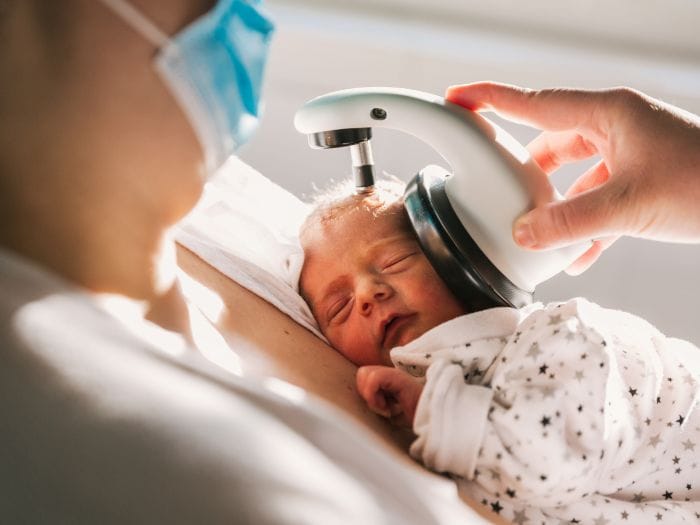The steady-state auditory response (ASSR) is an electrophysiological measure that captures the brain’s response to rapid auditory stimuli. Its primary objective is to estimate an individual’s hearing thresholds, which helps address the severity of hearing loss and aural rehabilitation questions.
ASSR offers a valuable alternative for hearing care professionals when traditional behavioural tests are not feasible or not suitable for the patient. It relies on statistical-based mathematical detection algorithms to determine the presence and level of auditory thresholds.
Difference between ASSR and ABR
The Auditory Steady-State Response (ASSR) shares similarities with the Auditory Brainstem Response (ABR) but has essential distinctions. ASSR and ABR involve recording bioelectric activity using similar electrode placement on the scalp and are categorised as auditory evoked potentials. Additionally, they utilise acoustic stimuli delivered through insert phones for optimal results.
However, there are vital differences between ASSR and ABR. While ABR relies on amplitude and latency measurements, ASSR focuses on amplitudes and phases in the frequency domain. ASSR detects peaks across a spectrum rather than identifying peaks across a time-amplitude waveform. Moreover, ASSR employs high repetition rates with repeated sound stimuli, while ABR uses brief sounds at a relatively low repetition rate.
ABR recordings often require subjective interpretation by the examiner, who determines the presence of a response. This becomes more challenging as the ABR approaches the hearing threshold, where accurate decision-making is crucial. In contrast, ASSR employs an objective and sophisticated statistical algorithm for detecting and defining hearing thresholds.
ABR protocols typically test one ear at a time using clicks or tone bursts. On the other hand, ASSR can be performed binaurally and simultaneously evaluate four specific frequencies (500 Hz, 1,000 Hz, 2,000 Hz, and 4,000 Hz). Hence, it shortens the testing time.
Additionally, ASSR excels at estimating and distinguishing hearing levels within the severe-to-profound hearing loss ranges.
The ability to differentiate between these significant categories of hearing loss is crucial. For example, distinguishing between 75 and 95 dB hearing loss can have implications for decisions such as fitting conventional hearing aids for a child with a 75 dB SNHL or considering cochlear implant options for a child with a 95 dB SNHL.
Patient Population
ASSR is a valuable tool for estimating hearing thresholds in individuals unable or unwilling to engage in traditional behavioural tests. As a result, the primary candidates for ASSR encompass a diverse range of individuals, including but nor restricted to:
- Newborn infants: ASSR is beneficial for conducting follow-up diagnostic assessments in newborns if they have failed the screening.
- Neonatal Intensive Care Unit (NICU) babies: ASSR can be used to assess hearing in infants receiving care in the NICU.
- Individuals with suspected issues related to their visit: ASSR is a valuable tool for workers’ compensation cases, legal matters, insurance claims, and similar scenarios where there are concerns regarding the hearing.
- Other cases: ASSR can apply to various situations where behavioural measures are challenging or not feasible.
ASSR’s flexibility and objective nature make it an invaluable option for assessing hearing thresholds in these diverse patient populations.
The Listening Lab Singapore
Our audiologists will conduct a comprehensive evaluation, including ASSR testing when needed, to determine candidacy and provide appropriate advice based on the results obtained from different assessments.
Remember, the decision to undergo cochlear implantation is significant, and thorough assessments such as ASSR testing contribute to the procedure’s success, especially for very young children. By leveraging the benefits of this objective evaluation, candidates can be given an accurate diagnosis resulting in a reliable candidacy assessment.
Auditory Steady State Response (ASSR) and ABR testing is valuable in estimating auditory thresholds for cochlear implant candidates and other diagnostic assessment in Singapore. Through this objective evaluation, candidates’ hearing thresholds are measured with high accuracy, enabling programming of the hearing aids with frequency-specific information and prediction of benefits from the device. The Listening Lab Cochlear Implant Centre utilises ASSR testing to provide diagnosis, maximising the benefits of hearing aids and ensuring optimal amplification of device before considering cochlear implant. Enquire today to learn more about candidacy assessment for yourself or your loved one.
